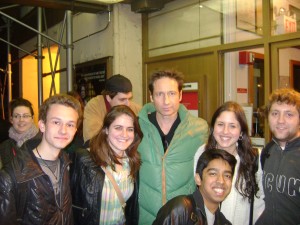A Big Break for the Lucile Theater?
“It used to be a movie theater and it is the oldest one in the area that’s still standing remains untouched. Keep note of that and look around while you are there. You will see what I am talking about.” A fellow on the street relayed this information to me, unprovoked, after I simply asked for direction to the Lucile Theater. He insisted that I know some history before I entered the theater. Considering I knew little to nothing about what I was going to see and where, I found this tidbit of information very interesting.
As soon as I reached the theater, I saw exactly what that man was talking about. It was an old and modest looking theater with some very old movie posters on the wall. I was surprised to find out that such big starts as David Duchovney and Amanada Peet were going to be in the production. I was eagerly waiting for the performance.
The show started abruptly with a loud crash and flashing lights, and if I was not already, I became awake and alert. With a torn shirt, disheveled hair, and an exposed bloody leg, David Duchovney’s character, John Smith, in Breaking Noon sure looked like he had been through trauma, but he definitely did not act like it. David Duchovney’s monotone performance was very disappointing. He seemed unnaturally calm for someone who has just eye witnessed a killing spree prior to hearing the voice of God. I was expecting more from such a well-known actor. Amanda Peet on the other hand, even with the difficult task of playing two different characters, gave a much better stage performance. I think it was a better performance than I have ever seen her give before.
But it seemed that their lesser-known co-actors, Tracee Chimo and John Earl Jelks, out shined both Amanda and David. They both had such a great stage presence and truly became their characters. I was hard for me to even realize, until after the show, that they each played two very distinct roles.
One thing that stood out in my mind about the show was how successful they were able to portray a scene with such a modest set. Throughout the entire performance there were only a few props, yet the plot was so captivating that it is hard to say if they needed those props at all. I admire the fact that they used only a minimal amount of props, because it really forces the actors to completely hold the attention of the audience, and for the most part they did.



